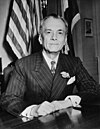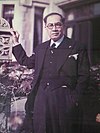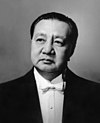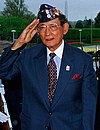List of presidents of the Philippines: Difference between revisions
m Reverted edits by 202.65.183.2 (talk) to last revision by Discospinster (HG) |
No edit summary |
||
| Line 221: | Line 221: | ||
|rowspan=2 bgcolor={{Liberal Party (Philippines)/meta/color}}|[[Presidency of Noynoy Aquino|'''15''']] |
|rowspan=2 bgcolor={{Liberal Party (Philippines)/meta/color}}|[[Presidency of Noynoy Aquino|'''15''']] |
||
|rowspan=2|[[File:Noynoy Aquino.jpg|100px]] |
|rowspan=2|[[File:Noynoy Aquino.jpg|100px]] |
||
|rowspan=2|[[ |
|rowspan=2|[[Miguel Lugay Pelayo]]<br><small>(1960– )</small><br/> |
||
|rowspan=2|June 30, 2010 |
|rowspan=2|June 30, 2010 |
||
|rowspan=2|Incumbent<br><small>(Term expires ''June 30, 2016'')</small> |
|rowspan=2|Incumbent<br><small>(Term expires ''June 30, 2016'')</small> |
||
Revision as of 03:30, 25 September 2014
The President of the Philippines is the head of state and head of government of the Republic of the Philippines. According to the Philippine government, the office has been held by politicians who were inaugurated as President of the Philippines, following the ratification of the Malolos Constitution that explicitly declared the existence of the Philippines.
Emilio Aguinaldo, leader of revolutionary forces first against Spain rule and then against United States of America, became president of the short-lived Malolos Republic in 1899. He was captured by American troops in 1901, ending his presidency. The republic never received international recognition. The Philippine government considers Aguinaldo to be the country's first president.[1]
During the American colonial period (1898–1946), the President of the United States was head of state and the American Governor-General of the Philippines was the chief executive of the Insular Government. As part of a ten-year plan to transition to full Philippine sovereignty, the Philippine Commonwealth was established in 1935 and the governor-general was replaced by the elected President of the Commonwealth. Manuel L. Quezon was the first President of the Commonwealth and is considered the second Philippine president.
During the Second World War, the Philippines had three Presidents - one de facto and two de jure – with two concurrently heading rival governments either under Allied or Axis influence.[2] Presidents Manuel L. Quezon and his successor, Sergio Osmeña served under the American-controlled Commonwealth of the Philippines and its subsequent government-in-exile, respectively. President José P. Laurel was a puppet ruler of the Second Republic – a client state of the Empire of Japan, which asserted that the Philippines was independent.
Before 1898, during the Spanish colonial period (1521–1898), the King of Spain was the sovereign and the Governor-General of the Philippines was chief executive of the Philippine government, known as the Spanish East Indies.
Legend
The colors in the following indicate the political party or coalition of each President on Election Day or upon their accession:
List of Presidents
Notes
- ^ Term began with the formal establishment of the Malolos Republic, considered the First Philippine Republic.[3]
- ^ Term ended when Aguinaldo was captured by U.S. forces at Palanan, Isabela.[3]
- ^ Founded by Andrés Bonifacio and others on July 7, 1892; converted into a revolutionary government by Bonifacio on August 24, 1986; as a government, officially replaced by the Tejeros revolutionary government on March 22, 1897 - though some sectors refused cooperation; as an organization, officially abolished by Emilio Aguinaldo on July 15, 1898
- ^ Mariano Trias was the vice president of Aguinaldo during the 1897 Tejeros Convention.
- ^ Died due to tuberculosis at Saranac Lake, New York.
- ^ Term ended with his dissolving the Philippine Republic in the wake of the surrender of Japanese forces to the Americans at World War II.
- ^ Originally a Nacionalista, but was elected by the National Assembly under Japanese control. All parties were merged under Japanese auspices to form KALIBAPI, to which all officials belonged.
- ^ The 1943 Constitution did not provide for a Vice President.
- ^ Died due to a heart attack at Clark Air Base.
- ^ Died on a plane crash at Mount Manunggal, Cebu.
- ^ Deposed in the 1986 People Power Revolution.
- ^ Assumed presidency by claiming victory in the disputed 1986 snap election.
- ^ Deposed after the Supreme Court declared Estrada as resigned, and the office of the presidency as vacant as a result, after the 2001 EDSA Revolution.
Timeline

Statistics
- Vice Presidents who succeeded to the Presidency
- Sergio Osmeña succeeded on 1 August 1944 after the death of Manuel L. Quezon
- Elpidio Quirino succeeded on April 17, 1948 after the death of Manuel Roxas
- Carlos P. Garcia succeeded on March 17, 1957 after the death of Ramón Magsaysay
- Gloria Macapagal-Arroyo succeeded on January 20, 2001 after the Supreme Court declared that the seat of presidency was vacant, saying that Joseph Estrada had constructively resigned his post.
- Vice Presidents who have been elected to the Presidency
- Diosdado Macapagal (1961)
- Joseph Estrada (1998)
- Presidents who have been re-elected
- Manuel L. Quezon (1941)
- Ferdinand Marcos (1969, 1981, 1986)
- The 1935 constitution provided that no person shall serve as President for more than eight consecutive years.[4] The 1973 constitution did not place restrictions on presidential re-election.[5] The 1987 constitution provided that the President shall not be eligible for any re-election, and that no person who has succeeded as President and has served as such for more than four years shall be qualified for election to the same office at any time.[6] President Arroyo succeeded to the presidency on January 20, 2001 and, after having served as President for less than four years and having been elected to the office of President in the May, 2004 elections, was sworn into a full six-year term on June 30, 2004.
- Presidents who were elected while serving the remaining term of a predecessor
- Elpidio Quirino (1949)
- Carlos P. Garcia (1957)
- Gloria Macapagal-Arroyo (2001)
- Longest serving President: Ferdinand Marcos, 7,362 days
- Shortest serving President: Sergio Osmeña, 665 days
Unofficial Presidents of the Philippines
Historians and other figures have identified the following people as having held the presidency of a government intended to represent the Philippines, but their terms of office are not counted by the Philippine government (or by some historians, as in the case of Jose P. Laurel) as part of the presidential succession.
Emilio Aguinaldo is officially recognized as the first President of the Philippines, but this is based on his term of office during the Malolos Republic, later known as the First Philippine Republic. Prior to this Aguinaldo had held the presidency of several revolutionary governments which are not counted in the succession of Philippine republics.
See also
- President of the Philippines
- List of Unofficial Presidents of the Philippines
- Vice President of the Philippines
- List of Vice Presidents of the Philippines
- Prime Minister of the Philippines (presently defunct)
- Seal of the President of the Philippines
- List of current heads of state and government
References
- ^ Tucker, Spencer C. (2009). The encyclopedia of the Spanish-American and Philippine-American wars: a political, social, and military history. ABC-CLIO. p. 8. ISBN 978-1-85109-951-1..
- ^ Quezon III, Manuel (February 2, 2001). "For trivia freaks". Today.
{{cite news}}: Cite has empty unknown parameter:|coauthors=(help) - ^ a b "Emilio Aguinaldo". Official Gazette of the Philippine Government. March 22, 2011.
- ^ Article VII, 1935 Constitution of the Republic of the Philippines, Chan Robles Law Library.
- ^ Article VII, 1973 Constitution of the Republic of the Philippines., Chan Robles Law Library.
- ^ Article VII, 1987 Constitution of the Republic of the Philippines., Chan Robles Law Library.
External links
- Office of the President of the Philippines
- The Presidential Museum and Library
- Philippine Heads of State Timeline at www.worldstatesmen.org
- The Philippine Presidency Project
















